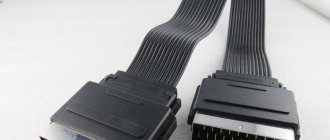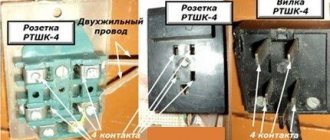The peculiarity of this conversion is that in relation to video it is necessary to carry out the reverse conversion (to analogue), and the audio signal must be separated into a separate path. The article provides a circuit diagram of an HDMI-VGA converter (adapter) and the operating principle of this circuit. To make it clearer what we are talking about, it’s worth mentioning right away that the HDMI-VGA adapter does not consist of wires alone. The HDMI-VGA cable is a microassembly circuit that cannot be soldered “quickly” on your knee. The HDMI to VGA converter is as “uncomplicated” as the VGA-HDMI adapter. Functional diagram of the HDMI-VGA adapter with audio signal highlighted is shown below (assuming the HDMI receiver contains an internal EDID):
What is a VGA RCA adapter
The circuit of this device may seem complicated, but only until you understand it. What is this device? This is an adapter from tulips (RCA connectors) of analog video output to VGA D-Sub for 15 pins. The device reviewed here can be used to connect a DVD player or satellite tuner to a multimedia projector. Of course, provided that it is not possible to work directly using the same type of cable, which is usually common in cheap or outdated devices.
Types and applications of a VGA to HDMI adapter - who benefits from buying it
To “make friends” between two incompatible ports, engineers developed special converters - adapters. They have fundamental design differences. The following commonly used options are distinguished:
| Modification | Appearance | Peculiarities |
| Cable | Can only be used if the image output equipment has a function for recognizing analog information. | |
| HDMI to VGA converter adapter | Most often, this option is used to connect an old monitor to a modern, powerful video card; the second name is an active adapter. | |
| Portable model | It has a compact size and is connected to the required output depending on the situation (VGA to HDMI or HDMI to VGA). | |
| Converter | Provides the most reliable signal transmission, works effectively with any type of equipment, but has the most bulky form. |
NOTE!
Beware of scammers and unverified companies selling modifications of the first type. Often, unscrupulous manufacturers offer, under the guise of a quality product, two HDMI and VGA cable headbands connected in a primitive way, without taking into account the features of data conversion.
Adapters of this type have a wide range of applications:
- Connecting an old system unit to a modern monitor or TV, as well as reverse situations.
- Connecting an old projector to the digital input on a PC or similar equipment.
- Connecting multimedia devices (for example, game consoles) with television equipment and (less commonly) monitors.
Adapters of this type have a very wide scope of use and will be relevant for many years to come
Pinout
How to pinout a 15 pin D-Sub connector? The numbers go from left to right:
1 – RY (Pr). 2 – Y. 3 – BY (Pb). 4 – Ground – Brown. 5 – Ground – WhtBrown. 6 – Ground RY (Pr) – WhtRed. 7 – Ground Y – WhtGreen. 8 – Ground BY (Pb) – WhtBlue. 9 – Not needed. 10 – Ground. 11 – Not needed. 12 – DDC DAT. 13 – Horizontal Synchronization. 14 – Vertical Synchronization. 15 – DDC Clock.
For the VGA RCA adapter cable we need six pins out of the fifteen presented. How to properly wire connectors and contacts? Check out this picture and you will understand how and what to do.
So let's see what happened. If everything was soldered correctly, then you now have an adapter that can supply a video signal to VGA D-Sub on the 15 pins of the projector. You can see approximately what the final product should look like in the photographs presented in the article.
One hundred and fifty meters of VGA available to everyone
There are many situations when it is necessary to place the monitor at a considerable distance from the computer. The first thought that arises is to buy a longer cable. A completely reasonable solution, however, it has its pitfalls. Firstly, the maximum length of a VGA cable is 50 meters; further distortion (and therefore the additional purchase of special compensators) cannot be avoided. A cable of this length, of course, must be of proper quality, which leads us to the “second” - price. It would seem that the situation is hopeless - either endure the restrictions, or prepare to pay a hefty sum for the cable. But here we are saved by the soldiers of the British engineering front - the Adder company, which offers an inexpensive (even for home use) solution that allows you to transmit a VGA signal over a distance of up to 150 meters.
About the “lifebuoy” – inside. The name of the life-saving device is AdderLink LPV150 (from Line Powered Video, power via connection). The device, like any video extender, consists of two modules - a transmitter that connects to the VGA video source, and a receiver (receiver), which is located next to the remote VGA display. The two modules are connected using an inexpensive CAT5 twisted pair cable.
Both devices are powered via a USB connection on the transmitter side (the receiver does not require additional power, the current flows through the twisted pair cable). The maximum video resolution is 1080p, which is enough for almost any purpose. There are no connection problems, no dancing with a tambourine is required - AdderLink LPV150 supports DDC (a data transfer channel from the display to the video card and back, with its help the video adapter automatically adjusts to the monitor to work at the optimal resolution). Now a little about the dimensions of the device. Both the transmitter and receiver literally fit in the palm of your hand. This will allow you to install both devices unnoticed by prying eyes, which is important, since the manufacturer itself positions the extender as a device for digital signage, an advertising technology that involves displaying advertising information on one or more displays in crowded places. For example, relatively recently installed screens in the Moscow metro or advertising in supermarkets.
For fans of numbers, here is a list of device specifications:
Video resolution
Up to 1080p HD, including 1080i & 720p
Working distance
Up to 150 m
Connectors
Local device: VGA, USB (for power), RJ45 Remote device: VGA, RJ45
Physical Dimensions
Transmitter: 45mm, 63mm, 21mm (without cables) Receiver: 45mm, 63mm, 21mm (without cables)
Nutrition
Power supply via USB interface cable
Working temperature
0-40 C
An added benefit is that it is OS independent, so installation is plug-n-play and takes a few minutes (or how long does it take a person to walk 150 meters?).
Examination
Wire pairs with RCA plugs soldered at the ends can be usefully compressed with heat shrink to obtain greater rigidity. In general, now you can connect the result of your work and enjoy it (if everything was soldered together as needed). Paired wires, at the ends of which RCA plugs are attached, can be crimped with heat shrink to obtain greater rigidity.
In this case, we used a satellite tuner with a 3 RCA component video output as a signal source and a Sanyo multimedia projector, which did not have a separate video input of the same type. If at the moment it is not possible to verify the functionality of the resulting adapter, then you can only carefully inspect the entire structure and make sure that there were no omissions, and everything is soldered as indicated in the article.
How it works
The VGA source on the DDC channel reads the EDID contents from the video signal receiver to obtain a list of supported timing modes, and then the video source begins to transmit the video stream. The VGA cable transmits RGB signals and separately horizontal (HSYNC) and vertical (VSYNC) signals. The ADC synchronizes the VGA stream to the HSYNC rate to match the sampling rate. Incoming clock signals are clock aligned by the VGA decoder. The data availability (DE) signal indicates the active portion of the video. The VGA ADC does not output this signal, which is required for encoding an HDMI signal. The logical unit of the DE signal indicates the active pixels or visual part of the video signal. Logic zero DE indicates the video blanking period. The horizontal and vertical DE signal generation diagrams are shown below:
The DE signal is critical to receiving the correct HDMI stream. The absence of a DE signal can be compensated by an HDMI (Tx) transmitter with DE regeneration capability. Modern HDMI transmitters can generate a DE signal from incoming HSYNC and VSYNC signals using only a few configurable parameters such as HSYNC and VSYNC delays, active width and active height (as shown in the pictures above) to ensure HDMI signal transmission compatibility. The HSYNC delay determines the number of pixels from the rising edge of HSYNC to the rising edge of DE. VSYNC delay is the number of HSYNC pulses between the rising edges of VSYNC and DE. The active width shows the number of active pixels horizontally, and accordingly the active height is the number of lines of the active video. The DE generation function can also be useful for display capabilities such as centering the active video area in the center of the screen. Display position adjustment is mandatory for VGA input signals. The first and last pixel in the digitized analog input signal must not match or be close to any of the HSYNC or VSYNC pulses. The period when the DE signal is in a logic zero state (such as the vertical or horizontal blanking interval) is used to transmit additional HDMI data and audio packets and therefore cannot be disturbed. But this kind of displacement can be caused by a shift in the sampling phase of the ADC. It is expected that the active displacement area will be displayed as a black stripe on the visible area of the screen. For a composite video broadcast signal (CVBS), this phenomenon can be corrected by exceeding the horizontal scan area by 5% to 10% (overscanning). The VGA standard is designed to display active video without eliminating the display of any area. The picture is not rescanned and therefore adjusting the display position is very important for VGA to HDMI conversion. In the best case, by the time it is shown on the screen, the black bar can be automatically recognized and the image automatically centered, or its position manually adjusted in accordance with the information read from the display. If the VGA ADC is connected to the server scaler, then the active video can be properly scaled to fit the viewable area. However, scaling to correct video hotspot misalignment increases development costs and associated risks. The scaler, given, for example, a video template, can recognize the black area surrounding a small white square inside the active area as a useless area and remove it. After this removal, the white square will become a pure white background. On the other hand, an image consisting of half white and half black background would also appear distorted. Therefore, some mechanisms must be included to prevent such misrecognition. Once the HDMI Tx has captured and reconstructed the DE signal, it begins sending the video stream to the HDMI signal recipient, such as a TV. At the same time, built-in audio components (audio codec, for example) can also transmit audio stream via I2S, S/DIF or DSD to HDMI Tx. One advantage is that HDMI can carry video and audio simultaneously. When the VGA-to-HDMI adapter is enabled and the source is connected to the receiver, the microcontroller must read the EDID contents from the HDMI receiver through the DDC channel of the HDMI transmitter. The controller copies the first 128 bytes of the EDID to ROM over the VGA DDC channel with minor modification, since VGA DDC channels typically do not support the CEA extension used for HDMI. The table below provides a list of necessary changes:
| Change | Cause |
| Replacing EDID 0x14[7] from 1 to 0 | Shows analog VGA input |
| Replacing established timing, standard timing, preferred timing and detailing | Timing outside the maximum limit supported by the VGA converter and HDMI Tx must be changed to the maximum or lower |
| Setting 0x7E to 00 | No EDID expansion block |
| Replacement 0x7F | The checksum must be recalculated in accordance with the above changes |
Let us give, for example, a diagram for connecting the video digitizer (ADC) AD9983A, and below – the HDMI transmitter ADV7513. These are the most important components of the VGA-HDMI connector manufactured by ADI.
In principle, VGA-HDMI is not difficult to solder yourself if you have, for example, a soldering station, components, skill and interest... Now the ADV7513 harness:
What you need to understand
You should be aware that the adapter in question can ensure the operation and full functioning of a device that has a VGA video input only if it can automatically detect the type of incoming video signal. An indicator of this will be the ability to select the mode in which data will be transmitted to RGB/YPbPr. Usage will be positively impacted by sending these types of signals. Why is that?
The fact is that RGB and HV.sync (for example, data coming from the output of a personal computer’s video card) are converted to RGB, which has sync pulses in the green channel (Y). It, in turn, turns into the color-difference YPbPr. And as a result, we can conclude that these signals are not the same thing, although they can convey the same information. Therefore, carefully study what a VGA RCA adapter looks like.
The principle of operation of the VGA-HDMI cable and adapter for a monitor
A VGA to HDMI adapter for a monitor is essentially an analog-to-digital converter. That is, it receives visual and audio signals in an outdated format, processes them and transmits them to the user on an information output device. To perform all “manipulations,” the equipment does not need external power sources; it receives electricity from the resources of the system unit.
The most difficult thing is to convert analog information into “digital” and vice versa
What adapters can be made using twisted pair?
- VGA extenders are special cables that have D-Sub 15 pin connectors on both ends, while their input and output use the same technology.
- RCA (3xRCA) is used to transmit component video signals. There are three connectors at each end. Used when working with a DVD player and TV.
- RCA (D-Sub15pin) was discussed a little higher. Here are the components Y, Pr, Pb in VGA.
- To transmit analog audio, two pairs of stereo signals can be used simultaneously (4 RCA connectors at each end).
Which VGA←→HDMI cable or adapter is better to buy? Several popular options
And now you’ve already gone to the store, standing in front of the shelf and thinking about which model to prefer. Our editors once again offer to take advantage of an independent list of interesting and affordable offers, as of April 2022.
| Model | Device type | Average price in Russia |
| Rexant 17-6936 | Active adapter from HDMI to VGA | 610 |
| UC-01 Ultra HDMI-VGA | HDMI to VGA converter adapter | 550 |
| Palmexx PX/mom HDMI VGA | Portable adapter | 910 |
| Dr.HD 005004041 CV 123 VAH | Converter | 3320 |
VGA to HDMI adapter
How to make a SCART VGA adapter
Another interface that is widely used in players and other multimedia devices is SCART. The technology also uses analog data transmission, and the video format is RGB. Such a perfect match suggests that making a SCART to VGA adapter will not be difficult. And in fact it is true. Perhaps it will be even easier than soldering RCA tulips, because the principle of operation of the connectors is largely similar.
To make such an adapter, you also need to familiarize yourself with the pinout of the SCART plug. You will need to connect those contacts that match on both interfaces. It is important to be careful not to confuse anything: there are more common contacts, but their locations differ. By soldering all the contacts together, you can perform a preliminary check, and then “secure your success” with heat shrink. Technologically, the process is no different from the steps described above - the only difference is the amount of work and the shape of the connectors.
Limitation
The conclusion after reading this article should be trivial - the cost of purchasing or independently manufacturing such a VGA-HDMI adapter (connector) will be comparable to purchasing a new video card with an HDMI output.
Regardless of whether we are talking about a laptop or a desktop computer. Moreover, the manufacturer of the chips for the specified converter does not recommend them as a basis for new developments... VGA-HDMI connector. Scheme2015-07-20T09:27:48+03:00 Alexey KasyanovSwitchingswitchingThis article suggests familiarizing yourself with such a concept as the VGA-HDMI connector. To be more precise, this is a VGA-HDMI adapter. It is proposed to consider the structural, functional and circuit diagram of the VGA-HDMI connector (adapter), as well as learn the principle of its operation. After this, everyone will be able to draw their own conclusion about assembling a VGA-HDMI adapter on their own. Consumer market...Alexey KasyanovAlexey KasyanovEditor Digitization of video, audio, photo
VGA-HDMI adapter. Assembly diagram
This article suggests familiarizing yourself with such a concept as the VGA-HDMI connector.
To be more precise, this is a VGA-HDMI adapter. It is proposed to consider the structural, functional and circuit diagram of the VGA-HDMI connector (adapter), as well as learn the principle of its operation. After this, everyone will be able to draw their own conclusion about assembling a VGA-HDMI adapter on their own. The consumer market has embraced HDMI connection technology in televisions, projectors and other devices. And this made the high-definition multimedia interface internationally recognized and soon mandatory for use in all multimedia gadgets. Already popular in home entertainment, HDMI is becoming increasingly common in mobile devices and car infotainment systems. However, in some industrial applications the transition from analog to digital video takes longer than in the consumer market, and many devices are not yet up to date with the new digital approach of transmitting video, audio and data simultaneously on a single channel.
These devices still use an analog signal, but only provide video transmission, perhaps due to the specific requirements of a particular market or application.
For example, some customers still prefer to use VGA cables for projectors, while others use an audio/video receiver (AVR) or VGA-to-HDMI set-top box as a hub, connecting to the TV with just one HDMI cable instead of an unattractive bundle of cables. , as it shown on the picture:
For new adopters, HDMI can seem like a relatively complex standard to implement, requiring driver approval, interoperability checks, and conformance testing to ensure that one device behaves properly in conjunction with various others. It's a little shocking at first, but that's often the case with new technologies.
This is why there is a periodic need to connect devices of different generations into one harness, which means connecting (or making a connector) VGA with HDMI (and vice versa) even at home.
However, modern advances in the element base make this problem less and less significant, and there are improvements in both the analog and digital areas; they include high-performance blocks for equalizing low-level differential signals, more complex software algorithms and error correction.
While HDMI has actually become the generally accepted interface for HD video, on laptops and older system systems the most common interface is still VGA. Below we will show you how to combine these video technologies.
The key for VGA to HDMI adapters is to ensure that the video source is delivering a signal that matches the correct video standard. This is done by providing the video source with the appropriate content EDID, i.e. extended display identification data.
Once received, the proper video standard can be converted to the final HDMI standard. In other words, having all the data about the video signal recipient, you can get a full HDMI stream by converting analog video from VGA to digital with added identification data.
The functional diagram of the VGA-HDMI adapter will thus look like this:
The missing audio signal can be transmitted to, say, a TV, via a separate analog or digital path, since VGA only contains video.
Conclusion
Making an adapter for equipment operating on the VGA interface is a completely doable task. With a sufficient level of relevant skills and an understanding of how the two types of connectors work, you will be able to avoid mistakes and make a working adapter. Although the task seems difficult, at first glance, with a thorough approach to the matter, it is possible to solder an adapter that is not inferior to the store-bought counterpart.
Source
| Replacing EDID 0x14[7] from 1 to 0 | Shows analog VGA input |
| Replacing established timing, standard timing, preferred timing and detailing | Timing outside the maximum limit supported by the VGA converter and HDMI Tx must be changed to the maximum or lower |
| Setting 0x7E to 00 | No EDID expansion block |
| Replacement 0x7F | The checksum must be recalculated in accordance with the above changes |











